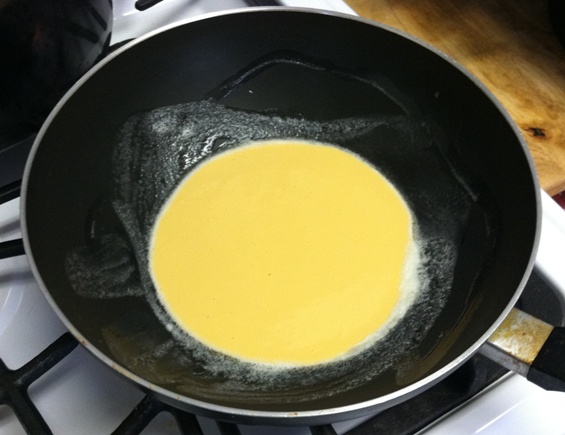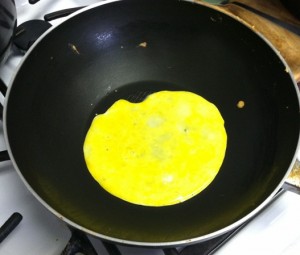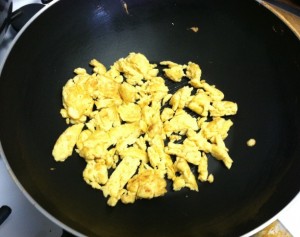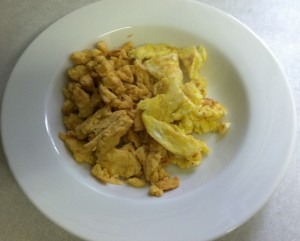Have you ever actually eaten powdered eggs? I know theres all sortsa stories from military folk talking about the horrors of such tings, but those stories are also usually pretty dated. Food preservation (and fabrication) technology has changed a bit.
Being an unapologetic bargain hunter, I always peruse the ‘marked down’ shopping carts in the back of the store where my local supermarket dumps the stuff it wants to sell now. Usually it’s things no one wants like sugar-free cake frosting, squirrel-flavored olive oil, dill pickle flavored barbecue sauce, and other ‘food’ items that are obviously not moving and taking up valuable shelf real estate.
So, the other day as I was sifting through the cart I found this:

My history with powdered eggs is a long one. I originally wanted some back in the late ’90s but had no idea for a source. I found this particular brand, Deb El, but found out they did not offer any larger quantity of them than these cans and some industrial-sized 50# bags that I was in no position to repackage. A few years later I discovered ‘Wakefield’ powdered eggs (an excellent product) but its availability was spotty since it was basically manufacturer overruns from .gov contracts (they can sometimes be found through REI). Finally, I found that Mountain House offered #10 cans of eggs and I picked up a few cases of that. Later on I found that Augason Farms offers whole eggs in the far more convenient #2 size cans…and scrambled egg mix in the larger #10 cans. I got a buncha those as well.


The first time I used powdered eggs I was extremely skeptical… the powder, when mixed with water, made this foul-smelling, orange-colored, pancake-batter-consistency mix that looked amazingly unappetizing. but, after a couple minutes in a frying pan with some butter it was like some sort of culinary magic trick – the orange turned into that lovely scrambled-egg-yellow that we all know and love, the smell was just like regular scrambled eggs, and the texture, while quite uniform, was also very similar. In fact, the giveaway that fresh eggs were not used came from the even coloring of the eggs….’real’ scrambled eggs have random flecks of white among the yellow. These were an even yellow across the board. But….absolutely delicious and indistinguishable, taste wise, from fresh eggs.
The powdered eggs are a bit more orange-y colored that fresh eggs, but in the half-light of your average apocalypse-induced power failure you probably won’t notice the difference. However, here’s a comparison of the powdered egs [first photo] cooking versus the fresh eggs cooking [second photo]:


Takes about two minutes to cook. Powdered:
 Fresh:
Fresh: 
Side by side on a plate you can see the color difference. (Too be fair, I used much more butter with the powdered eggs and virtually none with the fresh, so that may contribute to the color difference.) However texture is identical:

The powdered eggs come out looking not as good as the bright-yellow fresh eggs, but they have a far greater shelf life and lend themselves to mass feeding. Ever go to a hotel that has a breakfast bar and you can get all the omelettes you want? Notice the cook often has a juice bottle or container full of egg mix he pours or dips from? Yeah. Thats powdered egg (or liquid egg mix from powder) that he’s using.
So what good is this stuff? Well, for starters, if your breakfast includes scrambled eggs, french toast, or anything that requires an egg….well, heres your egg. No refrigeration necessary (although refrigerating eggs is, I am told, a mostly American notion. In Europe eggs are left at room temperature.) When Hurricane Sandy knocks out the power and the morning promises a long day of grunt work it’d be nice to be able to have scrambled eggs to go with the canned bacon, canned hash, or other breakfast fare. (According to my research, a post apocalyptic breakfast can be pretty impressive – scrambled eggs, hash, bacon, breakfast cereal with milk, oatmeal, canned fruit, orange drink, and coffee….a better breakfast than I have now.) And, of course, anything that requires egg like pasta dough, breaded foods, etc, etc, are going to be needing this stuff as well.
So…for those of you who may be curious about powdered eggs but don’t feel like cracking open a $40 #10 can of them for an experiment…well, I risked $4 to show you what to expect:
My suggestion to you? Buy the long term eggs in the smaller cans (because once you open a can of powdered eggs it’ll start drawing moisture and if you dont use it soon it’ll cake solid). Don’t expect it to taste/look exactly like fresh eggs, but don’t be terrified about it either. Its about the same quality as fastfood/breakfast bar/college cafeteria eggs.







 Fresh:
Fresh: 
